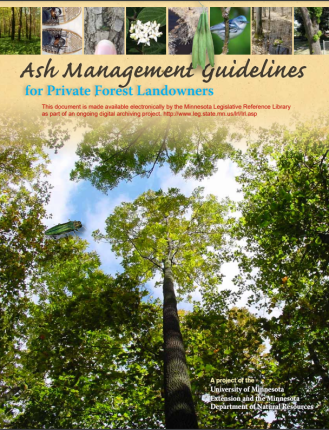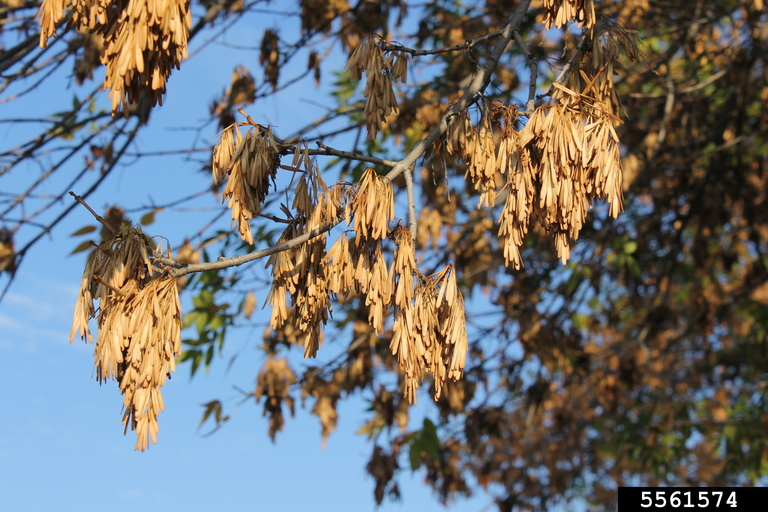
EAB-Infested Ash Trees
Insecticide Treatment Season
Insecticide Options for Protecting Ash Trees from Emerald Ash Borer
April 2019 - The most current, up-to-date information and research on if, when, and how to treat ash trees is available in this bulletin.
Silvicultural Recommendations for Ash
EAB Cost Calculator
This version is driven by an EAB invasion wave model that lets you modify your treatment strategy after the initial wave of EAB has passed. It can produce estimates of forests that contain up to 4,000 ash trees.
Ash Management Guidelines for Private Forest Landowners
 University of Minnesota Extension and the Minnesota Department of Natural Resources - Chosen for a 2012 Notable Documents Award from the National Conference of State Legislatures (NCSL) for public policy, recognizing the publication as innovative in providing substantive information on contemporary issues of interest.
University of Minnesota Extension and the Minnesota Department of Natural Resources - Chosen for a 2012 Notable Documents Award from the National Conference of State Legislatures (NCSL) for public policy, recognizing the publication as innovative in providing substantive information on contemporary issues of interest.
Treatment Information
Emerald Ash Borer and your Woodland
September 2007 - Dealing with EAB as a woodland owner in Michigan & surrounding states.
- Emerald Ash Borer Control
-
From the Michigan State University Knight Center for Environmental Journalism.
View original story »
© 2011, Great Lakes Echo, Michigan State University Knight Center for Environmental Journalism. Republish under these guidelines. Reporting supported by the John S. and James L. Knight Foundation.
Managing Emerald Ash Borer: Decision Guide
2016 - A step-by-step guide to help you manage your ash trees.
Insecticide Options for Protecting Ash Trees from Emerald Ash Borer
April 2019 - The most current, up-to-date information and research on if, when, and how to treat ash trees is available in this bulletin.
EAB Insecticides: Label Guidance for Use Limits
February 2012 - From the Minnesota Department of Agriculture - Some insecticides used to control emerald ash borer (EAB) have annual per acre use limits. The Minnesota Department of Agriculture (MDA) offers this label guidance to help applicators and others comply with label directions, meet tree treatment objectives, and minimize environmental impacts. The MDA completed a special registration review of EAB insecticides in 2011. The review concluded that insecticides commonly used to control EAB are not likely to harm human health or the environment when used according to label directions.
Frequently Asked Questions Regarding Potential Side Effects of EAB Insecticides
February 2011 - Research and Extension Specialists from Michigan State University, the Ohio State University OARDC and Extension, and University of Minnesota Extension have put together a comprehensive publication that addresses questions and concerns regarding insecticide use to control emerald ash borer.
Coalition for Urban Ash Tree Conservation - EAB Management Statement
Canadian Letter of Support
The following contain useful information for professionals:
Ash canopy thinning and dieback photo illustration
September 2007 - Effectively treating EAB-infested ash trees can be tricky. Many people are unaware of the degree of infestation their ash tree(s) may have, so Dave Smitley, Michigan State University entomologist, has created this guide that explains the stages of ash canopy thinning and dieback. These stages may help the homeowner determine if it is worth the effort to try to save the tree, or if it may be best to take it down.
"Slow Ash Mortality" - SLAM Pilot Project
The SLAM project is a collaborative effort involving Michigan State University, the USDA Forest Service, USDA Animal and Plant Health Inspection Service (APHIS), Michigan Technological University (MTU), the Michigan Dept. of Agriculture and Rural Development (MDARD), the Michigan Dept. of Natural Resources (MDNR), and Michigan Conservation Districts in Michigan\'s Upper Peninsula. The goal of the SL.A.M. pilot project in Michigan\'s Upper Peninsula is to delay and slow the expansion of ash mortality by reducing populations of the beetle in newly-infested sites, outside of known EAB infestations.
EAB Research and Technology Development Proceedings
Research abstracts and other information addressing the EAB problem in North America. Note: There was no meeting 2010.IMPORTANT NOTE: Since the emerald ash borer's discovery in 2002, research has been ongoing to develop tools to control and eliminate this pest. Currently, there are a number of treatments available for use by homeowners or tree care professionals that can provide a varying degree of beetle control. A review of all options is recommended. As more methods are developed, more information will be available. References to commercial products or trade names do not imply endorsement by the entities supplying the information, or bias against those not mentioned. Reprinting of any material on this site cannot be used to endorse or advertise a commercial product or company.
Removal Information
Frequently Asked Questions Regarding Potential Side Effects of EAB Insecticides
February 2011 - Research and Extension Specialists from Michigan State University, the Ohio State University OARDC and Extension, and University of Minnesota Extension have put together a comprehensive publication that addresses questions and concerns regarding insecticide use to control emerald ash borer.
Coalition for Urban Ash Tree Conservation - EAB Management Statement
Canadian Letter of Support
Replacement Information
General Information
Minnesota GreenStep Cities -- Urban Forests and Soils
Minnesota GreenStep Cities is a voluntary challenge, assistance and recognition program to help cities achieve their sustainability and quality-of-life goals. This free continuous improvement program, managed by a public-private partnership, is based upon 29 best practices. Each best practice can be implemented by completing one or more actions at a 1, 2 or 3-star level, from a list of four to eight actions. These actions are tailored to all Minnesota cities, focus on cost savings and energy use reduction, and encourage civic innovation. This link outlines the Urban Forestry initiative part of the program.
My Ash Tree is Dead... Now What Do I Do?
March 2007 - Tips outlined to utilize the wood from the dead and dying trees in homeowner's yards.
Michigan
Alternative Tree Species Selection
This guide gives suggestions for species that should be considered in situations where a homeowner, landscape, or urban forester may have planted an ash in the past in Michigan\'s lower peninsula
Colorado
Colorado Tree Coalition
The Colorado Chapter of the American Society of Landscape Architecture, Colorado Nursery & Greenhouse Association, Colorado Tree Coalition and Colorado State University Extension have compiled a Front Range Tree Recommendation List to help choose the right tree for specific areas.
Indiana
Alternative Tree Species Selection
This guide gives suggestions for species that should be considered in situations where a homeowner, landscape, or urban forester may have planted an ash in the past in Michigan\'s lower peninsula
Minnesota
Minnesota GreenStep Cities -- Urban Forests and Soils
Minnesota GreenStep Cities is a voluntary challenge, assistance and recognition program to help cities achieve their sustainability and quality-of-life goals. This free continuous improvement program, managed by a public-private partnership, is based upon 29 best practices. Each best practice can be implemented by completing one or more actions at a 1, 2 or 3-star level, from a list of four to eight actions. These actions are tailored to all Minnesota cities, focus on cost savings and energy use reduction, and encourage civic innovation. This link outlines the Urban Forestry initiative part of the program.
Nebraska
ReTree for Nebraskas "Good Trees for the Good Life"
To promote species diversity, ReTree Nebraska has chosen a select group of preferred species that perform well in Nebraska but aren\'t widely planted. ReTree Nebraska\'s Good Trees for the Good Life helps individuals choose the right tree for their landscape while improving the species diversity and vitality of Nebraska\'s community forests.
Ohio
Ash Replacements for Urban and Woodland Plantings
2005 - OSU Ash Alert - In developing this guide for selecting tree species to use to replace ash, it was assumed that, if not for emerald ash borer, one or more of the ash species would be suitable for the planting. Tree species included in this guide, therefore, are generally of the same size as ash and grow well on sites suitable for one or more of the native ash species. You will not, for example, find tree species in this guide that grow to a maximum height of 25 feet and which would be suitable for planting under utility power lines, as ash would not be an appropriate tree for such a planting.
AshSeed
In response to extensive tree mortality by the EAB, ash seeds are being collected for long term storage to preserve genetic resources of the ash species. This has been a combined effort of the Agricultural Research Service and the Forest Service along with NRCS, BLM, and over 50 cooperators.
The National Plant Germplasm Ash Conservation Project Website
The National Plant Germplasm Ash Conservation Project Website
Mid-Atlantic Regional Seed Bank Website, Collection of Fraxinus (Ash)
Mid-Atlantic Regional Seed Bank Website, Collection of Fraxinus (Ash)
Recommendations for the collection of ash seed
 Recommendations for the collection of ash seed
Recommendations for the collection of ash seed